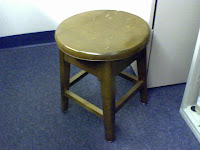
Many artists are inarticulate, really. Emotionally raw. They can't explain very well what they do. They just do it, albeit sometimes magnificently.
We have a little revolving art gallery here, so I read a fair number of artists' statements. Most tend to be vague, vapid, or sententious. Some have only the most tenuous of connections to the objects on the wall, making the reader/viewer feel stupid for "not getting it." Some are so bizarre one fears for the poor fellow's sanity.
The artist's statement here at the current exhibit is perfectly balanced, I think, between specificity and abstraction, intellect and emotion. It actually helped me in looking at the paintings!
I'll let the artist, Vincent McLoughlin, tell you what he does in his own words: "The panels...deal with three. Red. Yellow. Blue. Applied opaquely, translucently, and transparently in layers of three." Then he starts to intrigue me: the three colors make him think of Father, Son, and Holy Spirit; Plato's three-fold division of human psychology, the appetitive, the spirited, the rational; Darwin (variation, heredity, struggle for existence), Lincoln (government of, by, and for the people). A structured analysis, yet opening out to endless possibilities.
I found the paintings to look like kaleidoscope images. Crystals. No wait, they look like growing microorganisms. And look, there's an evolving eye! No, wait-- a city, a parliament, a cluster of berries! Love, growth, communion! And I liked thinking of the Trinity as the origin of it all.
In spite of the old adage to view from the distance, I found the paintings were even more intriguing close-up, once I understood the artist's technique.
Sometimes the artist is his own best critic. Certainly he should be his own best advocate.
We have a little revolving art gallery here, so I read a fair number of artists' statements. Most tend to be vague, vapid, or sententious. Some have only the most tenuous of connections to the objects on the wall, making the reader/viewer feel stupid for "not getting it." Some are so bizarre one fears for the poor fellow's sanity.
The artist's statement here at the current exhibit is perfectly balanced, I think, between specificity and abstraction, intellect and emotion. It actually helped me in looking at the paintings!
I'll let the artist, Vincent McLoughlin, tell you what he does in his own words: "The panels...deal with three. Red. Yellow. Blue. Applied opaquely, translucently, and transparently in layers of three." Then he starts to intrigue me: the three colors make him think of Father, Son, and Holy Spirit; Plato's three-fold division of human psychology, the appetitive, the spirited, the rational; Darwin (variation, heredity, struggle for existence), Lincoln (government of, by, and for the people). A structured analysis, yet opening out to endless possibilities.
I found the paintings to look like kaleidoscope images. Crystals. No wait, they look like growing microorganisms. And look, there's an evolving eye! No, wait-- a city, a parliament, a cluster of berries! Love, growth, communion! And I liked thinking of the Trinity as the origin of it all.
In spite of the old adage to view from the distance, I found the paintings were even more intriguing close-up, once I understood the artist's technique.
Sometimes the artist is his own best critic. Certainly he should be his own best advocate.


